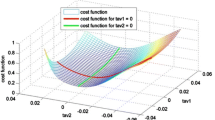Abstract
This paper presents a single-trial evoked potential (EP) estimation method based on an autoregressive model with exogenous input modeling and sparse coding. This method uses sparse coding instead of the autoregressive-moving-average model to model EPs, as the former is more flexible. The best matching atoms from the dictionary are used to represent the EP signal without needing to estimate the number of atoms beforehand. By transforming the electroencephalography signal into white noise, the single-trial EP estimation is transformed into a signal denoising problem for white noise. With the dictionary constructed specially for EPs, the EP signal can be extracted easily with sparse coding. Moreover, since the location of the atom in the dictionary has no influence on the effectiveness of sparse decomposition, variations of the amplitude and latency of EPs have only a minor impact on the performance of the proposed method. The proposed method can thus track EP signal variations. Experimental results also demonstrate that this method is effective.










Similar content being viewed by others
References
Costa, M. H. (2012). Estimation of the noise autocorrelation function in auditory evoked potential applications. Biomedical Signal Processing and Control, 7, 542–548.
Reynolds, C., Osuagwu, B. A., & Vuckovic, A. (2015). Influence of motor imagination on cortical activation during functional electrical stimulation. Clinical Neurophysiology, 126, 1360–1369.
Paul, J. S., Luft, A. R., Hanley, D. F., & Thakor, N. V. (2001). Coherence-weighted Wiener filtering of somatosensory evoked potentials. IEEE Transactions on Biomedical Engineering, 48(12), 1483–1488.
Georgiadis, S. D., Ranta-aho, P. O., Tarvainen, M. P., & Karjalainen, P. A. (2005). Single-trial dynamical estimation of event-related potentials: a Talman filter-based approach. IEEE Transactions on Biomedical Engineering, 52(8), 1397–1406.
Wang, Y. X., Qiu, T. S., & Liu, R. (2012). Few-sweep estimation of evoked potential based on a generalized subspace approach. Biomedical Signal Processing and Control, 7(8), 185–191.
Lange, D. H., Pratt, H., & Indar, G. F. (1997). Modeling and estimation of single evoked brain potential components. IEEE Transactions on Biomedical Engineering, 44(9), 791–799.
Garoosi, V., & Jansen, B. H. (2000). Development and evaluation of the piecewise Prony method for evoked potential analysis. IEEE Transactions on Biomedical Engineering, 47(12), 1549–1554.
Wang, Z., & Roe, A. W. (2011). Trial-to-trial noise cancellation of cortical field potentials in awake macaques by autoregression model with exogenous input (ARX). Journal of Neuroscience Methods, 194, 266–273.
Cerutti, S., Baselli, G., Liberati, D., & Pavesi, G. (1987). Single sweep analysis of visual evoked potentials through a model of parametric identification. Biological Cybernetics, 56, 111–120.
Kumru, H., Soler, D., Vidal, J., Tormos, J. M., Pascual-Leone, A., & Valls-Sole, J. (2012). Evoked potentials and quantitative thermal testing in spinal cord injury patients with chronic neuropathic pain. Clinical Neurophysiology, 123, 598–604.
Silva, A. C. D., Sinclair, N. C., & Liley, D. (2012). Limitations in the Rapid extraction of evoked potentials using parametric modeling. IEEE Transactions on Biomedical Engineering, 59(5), 1462–1471.
Yu, N. N., Liu, H. K., Wang, X. Y., & Lu, H. B. (2013). A joint sparse representation-based method for double-trial evoked potentials estimation. Computers in Biology and Medicine, 43(12), 2071–2078.
Yu, N. N., Ding, Q. S., & Lu, H. B. (2015). Single-trial evoked potentials extraction based on sparsifying transforms. Journal of Pharmacy and Pharmacology, 3, 556–561.
Corbier, C., & Carmona, J. (2012). Robust final prediction error criterion for control oriented models validation using L2–L1 norm, In 2nd International Conference on Communications, Computing and Control Applications (CCCA), Marseilles, France, (pp. 1–6).
Song, I., Park, P. G., & Newcomb, R. W. (2013). A normalized least mean squares algorithm with a step-size scaler against impulsive measurement noise. IEEE Transactions on Circuits and Systems II: Express Briefs, 60(7), 442–445.
Han, M., & Sun, L. L. (2010). EEG signal classification for epilepsy diagnosis based on AR model and RVM. In International Conference on Intelligent Control and Information Processing (ICICIP), Dalian, China, (pp. 134–139).
Zhang, Y., Ji, X., & Zhang, Y. (2015). Classification of EEG signals based on AR model and approximate entropy. In International Joint Conference on Neural Networks (IJCNN), Killarney, Ireland, (pp. 1–6).
Shental, O. (2011). Sparse Representation of White Gaussian Noise with Application to `0-Norm Decoding in Noisy Compressed Sensing, (pp. 1–7). eprint arXiv:1104.2215.
Chen, S. S., Donoho, D. L., & Saunders, M. A. (2001). Atomic decomposition by basis pursuit. SIAM Review, 43, 129–159.
Pati, Y. C. Rezaiifar, R., & Trishnaprasad, P. S. (1993) Orthogonal matching pursuit: recursive function approximation with applications to wavelet decomposition. In Conference on Record of 27th Asilomar Conference Signals System Computing (Vol. 1, pp. 40–44).
Yuan, L., Liu, J., & Ye, J. (2013). Efficient methods for overlapping group lasso. IEEE Transactions on Pattern Analysis and Machine Intelligence, 35(9), 2104–2116.
Acknowledgements
This work was supported by the Nature Science Foundation of China (Grant No. 61401181) and the Science and Technology Innovation Project of Xuzhou, China (Grant No. XZKJ8386).
Author information
Authors and Affiliations
Corresponding author
Rights and permissions
About this article
Cite this article
Yu, N., Ding, Q. & Lu, H. Single-Trial Estimation of Evoked Potential Signals via ARX Model and Sparse Coding. J. Med. Biol. Eng. 37, 209–219 (2017). https://doi.org/10.1007/s40846-016-0209-x
Received:
Accepted:
Published:
Issue Date:
DOI: https://doi.org/10.1007/s40846-016-0209-x




